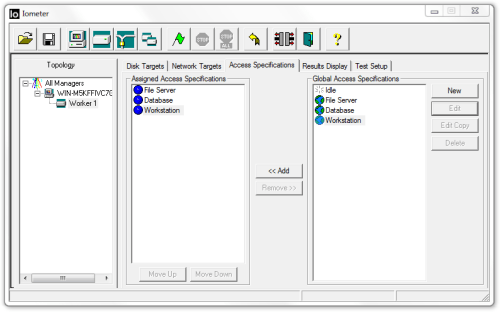- Qualcomm Launches Snapdragon 4 Gen 2 Mobile Platform
- AMD Launches Ryzen PRO 7000 Series Mobile & Desktop Platform
- Intel Launches Sleek Single-Slot Arc Pro A60 Workstation Graphics Card
- NVIDIA Announces Latest Ada Lovelace Additions: GeForce RTX 4060 Ti & RTX 4060
- Maxon Redshift With AMD Radeon GPU Rendering Support Now Available
Kingston SSDNow V300 120GB SSD Review

Looking for an affordable SSD but demand a high-performance controller? Kingston’s SSDNow V300 is shaping up to be just that. Powered by a SandForce SF-2281 controller and paired with Toshiba’s 19nm Toggle-based NAND, it’s an aggressive entrant for its price-point. Let’s check it out.
Page 4 – Synthetic: Iometer
Originally developed by Intel – and since given to the open-source community – Iometer (pronounced “eyeawmeter”, like thermometer) is one of the best storage-testing applications available, for a couple of reasons. The first, and primary, is that it’s completely customizable, and if you have a specific workload you need to test a drive with, you can easily accomplish it here. Secondly, it bypasses the Windows disk subsystem entirely, meaning it bypasses the OS drivers and writes directly to the storage media. This has important implications, such as it means Windows 7 cannot correctly align Iometer to match the SSD or HDD sector alignment.
We have updated our test suite to the latest stable 1.10 rc1 build of Iometer, which was released in December, 2010. This version makes some changes to be aware of; specifically, it gives the option for three types of data sets used during testing. 2006 and earlier versions used a pseudo-random dataset for testing, while the 1.10 build will default to a “repeating bytes” test pattern. A full random test mode was also added. To avoid giving SandForce drives an unfair advantage (they rely on data compression to achieve their performance), we will stick to the pseudo-random test pattern for all of our testing.
We have configured Iometer for correct 4KB disk alignment using a single 8GB test file from within Windows, meaning they are acting as the host OS drive with no other drives in the system. We run individual random 4KB read and write tests at a queue depth of 3 and again at 32. Then we run the 128KB sequential read & write tests using a queue depth of 1. In addition, all drives are in a dirty state prior to testing – this means results will not be comparable to advertised manufacturer results. Our goal is to measure end-user performance under real-world conditions, and so our testing reflects typical SSD performance after it has been used for some length of time in a system. Each test pattern is run for 5 minutes to achieve an average result.
In addition, we have created three Iometer disk usage scenarios that should roughly approximate database, file server, and workstation usage patterns. These scenarios are run individually for 10 minutes each within an 8GB file on the drive, which is an unusually harsh scenario for any sort of SSD. Drives that are able to offer better sustained performance over time and those that favor certain file size accesses will do well here. All three tests are configured for a queue depth of 32 to show which drives are best capable of dealing with heavy workload scenarios.
“IOPS” is simply the measure of performance relative to a certain disk access size, specifically 4KB or 512 bytes, or any size desired. Typically with SSDs when speaking about IOPS it is referred to on the assumption of 4KB accesses. With this in mind, it is easy to convert between IOPS and MB/s. Iometer provides both types of results to us and for the sake of concise graphs, brevity, and easily understandable results, we have elected to use MB/s for the 4KB and 128KB tests. For reference: IOPS = (MBps Throughput / KB per IO) * 1024 and MBps = (IOPS * KB per IO) / 1024.





Iometer is not a kind test to run on lower capacity SSDs and the results bear that out in the Read performance chart. Even so it’s still an all-around upgrade over a mechanical disk drive. Looking at writes however, the V300 is able to offer anywhere from 16-28 times the random 4KB performance of a large capacity HDD. The V300 even trumps the m4’s random results by a factor of three in the QD3 test, and up to five times the 4KB performance at a higher queue depth of 32.
The budget V300 may not be able to hang with the flagship SSDs in the three workload scenario tests, but surprisingly it is able to easily supersede the results of the m4 by a comfortable margin in all three scenarios.
Support our efforts! With ad revenue at an all-time low for written websites, we're relying more than ever on reader support to help us continue putting so much effort into this type of content. You can support us by becoming a Patron, or by using our Amazon shopping affiliate links listed through our articles. Thanks for your support!





